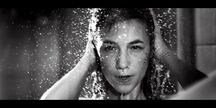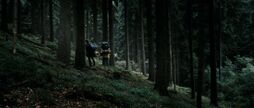Preset The
presupposed rebellion may come from the director's personal experience, and the wavering religious beliefs eventually lead to self-loss. However, under the director's helm, the Antichrist is more like a rebellion against the self. In the frantic world of consciousness, he places the hero and heroine in a muddy, filthy, ruined environment, tormenting them with mental pain.
Or maybe the director is torturing himself. When the fox tore his body and the eagle devoured his own child, Satan's breath was remembered in the director's mind. There is no way out of that extreme pain, only death. With such strong personal emotions, it is not difficult to decipher how manic and restless the director's state of mind was at that time. The world begins to deform in his eyes... The death of the child of the
miserable hero and heroine
is the trigger, but not the root, of the tragedy in the film. In the subsequent shots, the director can be seen from the bottom of the vase immersed in the turbid water, the interlaced plant roots, the male protagonist's hair, the river, the small bridge and other images imply the most real image state hidden in the hero and heroine's heart. With the promotion of the film may break out at any time.
The hero originally planned to deal with the heroine's trauma in a dense forest, but he didn't know that he actually took her into a more crazy world. Decayed dead wood, thick fallen leaves, dilapidated huts, and countless possibilities hidden in the dark world may mercilessly wrap them. Soon, the fear and grief in the hero's heart are aroused, and hallucinations arise from his heart. Whether he is redeeming his lover or himself is unknown.
I really want to know why in his eyes, the deer that ran away in a hurry like his wife gave birth to a child while running; I also wondered whether the fox biting his own flesh pierced his soul or whether he was sane Under the frenzy?
Chapters, Videos, Music
This is Lass von Trier's alternative "Bible". In the new and old chapters, the director struggled to tell the fables that caused the crisis, and also used his own hallucinations and death to confirm the authenticity of the fables.
The scenes full of pessimism in film noir are interpreted as beautiful and poetic by expressionism. The act of expressing inner pain through body intercourse is not dirty and dirty, but a means of collision of the soul and escape from reality. It's just that this method also appears pale and powerless under the huge psychological shadow, like the pale heroine's body part cut off by the camera.
In the end, the heroine chose to use violence to release her inner pain and guilt, and the picture changed from aesthetic and poetic expressionism to magical realism. That kind of weird style really makes people shudder.
The music and the picture are closely linked. The "Rinaldo, lascia ch'io pianga" in the gray and white slow motion at the beginning was sung very well by the girls, but the feeling revealed was very uncomfortable.
When
the subtitles came up, I was sure I was in love with the film, madly obsessed with the various shots in between. If you use Nietzsche's gender theory or rational and emotional terms to explain this film, it is understandable. What fascinated me was not the symbols and puzzles he set up in the movies, but the chills he forced me to generate.
View more about Antichrist reviews










